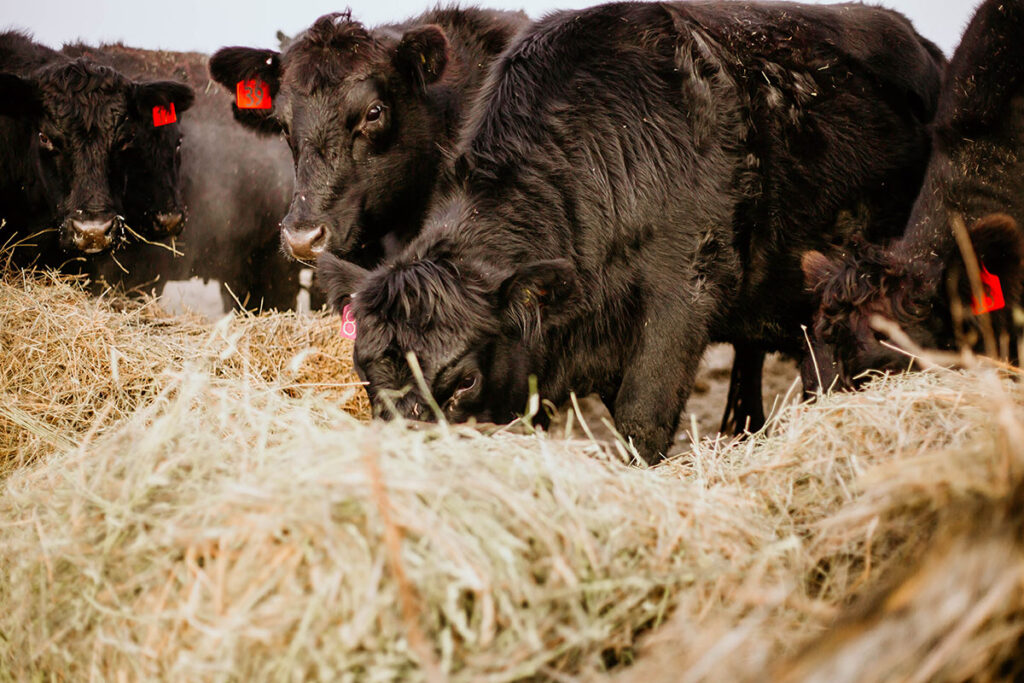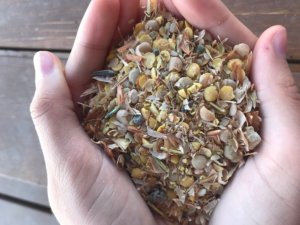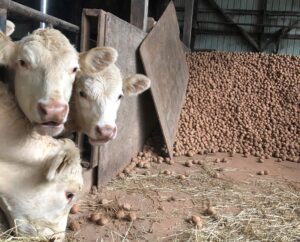Considerations When Using Alternative Feeds - Have You Done Your Homework? 🎙️
CLICK THE PLAY BUTTON TO LISTEN TO THIS POST:
Listen to more episodes on BeefResearch.ca, Spotify, Apple Podcasts, Amazon Music or Podbean.

Alternative or non-conventional feeds, such as grain screenings, cull potatoes or distillers’ grains, can be an economical means for beef cattle producers to supplement forage and grain inventories while continuing to meet animal nutritional requirements. However, due to variability in the supply, nutrient composition and quality of these feed ingredients, there can be pitfalls if not properly managed. Below are several key areas that producers can focus on when deciding if alternative feeds are a good fit for their farm.
Match feed composition to beef cattle groups
Two of the main components to creating a balanced ration for beef cattle is knowing the nutritional composition of the feedstuffs being used and their suitability for the type or group of cattle being fed. Ration-balancing tools, such as CowBytes, allow producers to input feed analysis results and ingredient costs to calculate appropriate rations that safely use alternative feeds and reduce the risk of digestive upsets.
Screenings from cereals, pulses or canola, can be cost-effective sources of protein and energy in the diet for mature cattle. However, inconsistency between loads and the potential for toxins requires feed testing to determine the true nutritional value. In comparison, soyhulls or beet pulp, which are byproducts of processing, typically contain a consistent amount of energy due to having a high level of digestible fiber. This makes them an excellent feed for most classes of cattle.
Feeds, such as straw and oat hulls, have a poor nutritional composition, but can be utilized as fibre sources to partially substitute forage in rations for mature cows in early and mid-gestation. It is recommended to restrict the use of these feeds in the diet of bred heifers, a group that requires a higher plane of nutrition to meet their own growth and development needs, along with the rising demands of pregnancy. Feeding high levels of straw also increases the risk of impaction.

If feeding low- to medium-quality forage-based diets or grazing crop residues, additional protein supplementation is often necessary. Byproducts such as canola meal, soybean meal or dried distillers’ grains (DDG) are high-quality protein feeds that can be easily fed in multiple feeding scenarios and to all classes of cattle. Supplementing cows that reach peak lactation in early spring can provide the added energy and protein needed to support milk production before pasture turnout.
There can be an increased risk of toxins with some alternative feeds due to the concentration of nutrients during processing or the presence of certain conditions at harvest and storage. For example, heated or sprouted grains have an elevated risk of moulds and mycotoxins, while cereal screenings increase the danger of ergot toxicity. These contaminants can lead to reduced production performance, fertility issues and abortions in cattle. It is recommended to avoid feeding to bred heifers, pregnant cows or cow-calf pairs. Feed testing is necessary for any suspect feeds.
Think about handling and storage
Consider storage and feeding requirements before purchasing alternative feeds. Having the proper facilities and feeding infrastructure will make incorporating these feeds easier.
Handling can be a challenge when working with high-moisture feeds such as cull potatoes or fruit and vegetable waste. These types of products can freeze in cold weather, making consumption by cattle difficult. For example, whole, frozen cull potatoes present a choking hazard when fed. To reduce this risk, the potatoes can be chopped using a tub grinder or crushed with equipment such as tractors. However, it is important to keep in mind that once processed, storage time is greatly reduced.

In addition, high-moisture products tend to ferment rapidly, especially when temperatures warm up. This creates potential spoilage issues, so it is recommended to feed quickly unless ensiled.
Feeds, such as chaff, oat hulls or screenings, can be bulky to transport and store. Covered commodity sheds can help reduce feed losses when compared to outside storage. The storage facilities used should be functional and well-maintained. These feeds are also dusty and ideally fed as part of a total mixed ration (TMR) with a wet ingredient or water included in the mix.
When thinking of on-farm ration preparation and feed delivery, consider the mixing characteristics of the novel feed, such as particle size, shape and density. Feeds with a fine particle size should be combined with other ingredients in a TMR to allow for the greatest utilization of the product. In contrast, larger particle feeds can be either fed on their own or mixed with other ingredients as part of a balanced ration.

What about costs – do they add up?
It is key to compare feeds on an equal nutrient basis and not simply on purchase price. This allows for a direct comparison between feeds. Consider the scenarios below (nutrient values expressed on a dry matter (DM) basis):
- Two protein sources are available: source 1 contains 30% protein and costs $350/tonne, while source 2 costs $375/tonne and contains 38% protein. The cost per unit of protein for source 1 is $1.17/kg. In comparison, the cost per unit of protein is $0.99/kg for source 2. Therefore, although protein source 1 is purchased at a lower price, it will end up costing more to feed the same amount of protein per head per day when compared to source 2.
- Assume corn grain is priced at $248/tonne and contains 88% total digestible nutrients (TDN). The cost per unit of energy is $0.28/kg. If grain screening pellets are available as an alternative energy source, and they contain 70% TDN, the breakeven price to pay for these pellets would be $195/tonne. It is important to remember that some screening pellets might be fortified with vitamins and minerals which must be considered when doing comparisons.
The BCRC’s interactive calculator for Evaluating the Economic Value of Feeds can help producers determine the value of feeds they are considering for purchase compared to the value of standard feeds. Keep in mind that it is important to use “dry matter” values rather than “as fed” when running cost comparisons.

Considerations when calculating the cost of transportation should include the distance hauled and the physical nature of the product itself. As an example, culled potatoes, culled onions or other fruit and vegetable wastes can have moisture contents ranging from 70-90%. This means that 1 tonne of these feeds at a dry matter of 25% would contain 750 kg of water! This greatly increases the transportation costs, especially over long distances. In addition, due to the high-moisture content, bedding costs may increase along with a higher risk of digestive upsets and buildup of manure tags.
Carefully manage the inclusion of alternative feeds
Local alternative feeds can be effective and economical additions to beef cattle rations. However, careful management is required to avoid potential problems and to ensure the nutritional requirements of the type of cattle being fed are met.
Sharing or reprinting BCRC posts is welcome and encouraged. Please credit the Beef Cattle Research Council, provide the website address, www.BeefResearch.ca, and let us know you have chosen to share the article by emailing us at info@beefresearch.ca.
Your questions, comments and suggestions are welcome. Contact us directly or spark a public discussion by posting your thoughts below.
